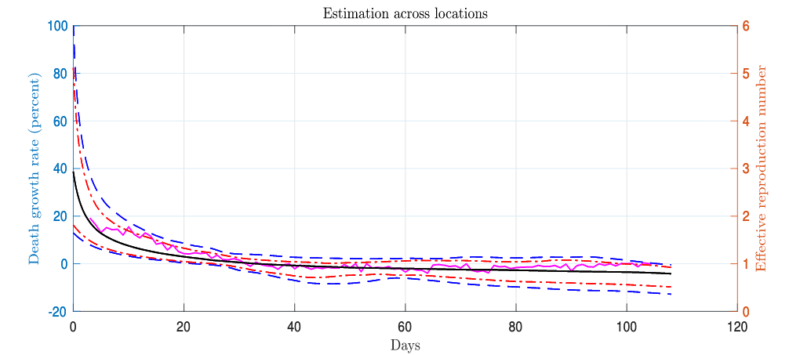Lockdowns and Mask Mandates Do Not Lead to Reduced COVID Transmission Rates or Deaths, New Study Suggests

A new National Bureau of Economic Research (NBER) working paper by Andrew Atkeson, Karen Kopecky, and Tao Zha focused on countries and U.S. states with more than 1,000 COVID deaths as of late July. In all, the study included 25 U.S. states and 23 countries.
Based on their analysis, the authors present four “Stylized Facts” about COVID-19, which are:
- Once a region reaches 25 total COVID deaths, within a month the growth rate in deaths per day falls to approximately zero. In other words, no matter the country or state and its policies, deaths per day stop increasing within 20-30 days of passing a threshold of 25 deaths.
- Once that happens, deaths per day either begin to fall or the trend remains flat.
- The variability in death trends across regions has fallen sharply since the beginning of the epidemic and remains low. All states studied, all countries studied, have become more similar in their trends and have remained so.
- Observations 1-3 suggest that the effective reproduction number, R, has hovered around one worldwide after the first 30 days of the epidemic.
The paper’s conclusion is that the data trends observed above likely indicate that nonpharmaceutical interventions (NPIs) – such as lockdowns, closures, travel restrictions, stay-home orders, event bans, quarantines, curfews, and mask mandates – do not seem to affect virus transmission rates overall.
Why? Because those policies have varied in their timing and implementation across countries and states, but the trends in outcomes do not.

From the study’s authors:
Location and sampling uncertainty. The black solid line in both charts represents the median posterior estimate. The solid magenta line in the top chart represents the median growth rate of 7-day smoothed daily deaths for all 50 locations and corresponds only to the left scale. The two dash-dotted bands in both charts contain two thirds of the posterior probability at each point in time and the two dashed bands, 0.90 of the posterior probability. The growth rates of death is estimated according to the fitted Weibull function. Effective reproduction numbers and normalized transmission rates are based on the SIR model. Day 0 is the earliest date when the cumulative death toll reached 25 in each location.
This study runs counter to previous studies claiming that NPIs were effective in reducing transmission rates during the early stages of the epidemic. The authors explain:
Given the observation that transmission rates for COVID-19 fell virtually everywhere in the world during this early pandemic period, we are concerned that these studies may substantially overstate the role of government-mandated NPIs in reducing disease transmission due to an omitted variable bias.
One of the key candidates for the key “omitted variable,” i.e. the true cause of the decline in transmission rates after the first month of an epidemic, is that human interaction does not conform to simple epidemiological models. In the real world human social networks overlap in such a way that a virus can spread rapidly for a short period of time, as some people contact more networks than others, but reaches natural dead-ends and roundabouts where potential new hosts in a “new” social network have already been exposed through other networks. The effect can resemble what some think of as “herd immunity,” but at relatively low infection rates.
The authors reason that even if NPIs were effective early on, they do not appear to be anymore:
Moreover, given the observation that disease transmission rates have remained low with relatively low dispersion across locations worldwide for the past several months as NPIs have been lifted, we are concerned that estimates of the effectiveness of NPIs in reducing disease transmission from the earlier period may not be relevant for forecasting the impact of the relaxation of those NPIs in the current period, due to some unobserved switch in regime.
This study provides strong statistical support for what so many have been observing for six months. The epidemic has a natural tendency to spread quickly at first and slow down, seemingly on its own, a point made not only here but as early as April 14 by Isaac Ben-Israel. Meanwhile governors imagine that very specific rules for opening bars and restaurants are the key to containment.
Governments have conducted an unprecedented social, economic, and political experiment in controlling whole populations’ behavior, with high economic and human cost. The authors ask the right question: has this experiment in government-managed virus control and suppression made a difference? The startling answer they found, after examining data from around the country and the world, is that the evidence simply is not there.
If we are concerned about the evidence on this global experiment, we must concede that most government authorities have likely acted in error.










